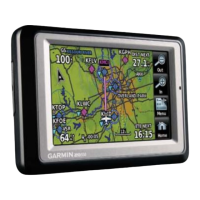Garmin aera 500 Series Pilot’s Guide
190-01117-02 Rev. C
97
Hazard Avoidance
Overview GPS Navigation Flight Planning Hazard Avoidance Additional Features Appendices Index
radar synopsis. Due to the inherent delays and the relative age of the data, it should
be used for long-range planning purposes only. Never use NEXRAD data or any radar
data to maneuver in or near areas of hazardous weather.
Composite data from all the NEXRAD radar sites in the United States is shown. This
data is composed of the maximum reflectivity from the individual radar sweeps. The
display of the information is color-coded to indicate the weather severity level.
The display of radar coverage is always active when NEXRAD is selected. Areas
where NEXRAD radar coverage is not currently available or is not being collected are
indicated in grayish-purple on the NEXRAD weather page. Radar capability exists in
these areas, but it is not active or is off-line.
NEXRAD Abnormalities
There are possible abnormalities regarding displayed NEXRAD images. Some, but
not all, of those include:
•Groundclutter
•Strobesandspuriousradardata
•Sunstrobes,whentheradarantennapointsdirectlyatthesun
•Militaryaircraftdeploymetallicdust(chaff)whichcancausealterationsinradar
scans
•Interferencefrombuildingsormountains,whichmaycauseshadows
•PoorreceptionfromGroundBasedTransceivers(GBTs)cancauseportionsofthe
received radar imagery to not be displayed
NEXRAD Limitations
Certain limitations exist regarding the NEXRAD radar displays. Some, but not all, are
listed for the user’s awareness:
•NEXRAD base reectivity does not provide sufcient information to determine
cloud layers or precipitation characteristics (hail vs. rain). For example, it is not
possible to distinguish between wet snow, wet hail, and rain.
•NEXRADbasereectivityissampledattheminimumantennaelevationangle.An
individual NEXRAD site cannot depict high altitude storms at close ranges, and
has no information about storms directly over the site.

